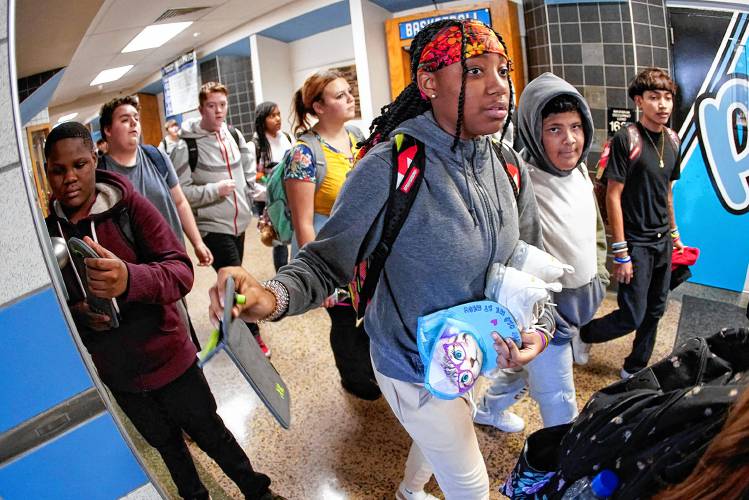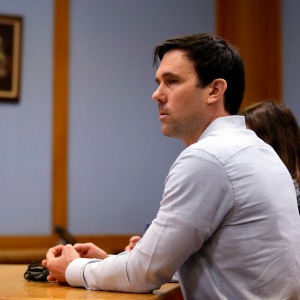Editorial: Friends don’t let friends text and learn

Students at the Washington Junior High School leaving classes for the day, use the unlocking mechanism to open the bags their cell phone were sealed in during the school day, Thursday, Oct. 27, 2022, in Washington, Pa. Citing mental health, behavior and engagement as the impetus, many educators are updating cellphone policies, with a number turning to magnetically sealing pouches. (AP Photo/Keith Srakocic) Keith Srakocic—AP
| Published: 09-06-2023 10:43 AM |
The Claremont and Newport school districts made the right call and sent an important message in tightening restrictions on cell phones for the coming academic year. We believe students will benefit socially, emotionally and educationally as they try to make up ground that was lost during the pandemic.
As our colleague Patrick O’Grady reported last week, principal Chris Pratt made the decision to institute a complete ban on cell phones during the school day at Stevens High School in Claremont. Newport is banning the devices at the middle school during the day and ramping up enforcement of its restrictions at the high school.
Should you think that this is an overreaction, take heed of the observations of SAU 43 Superintendent Donna Magoon, who noted that while Newport, like Stevens, already banned cell phone use during instructional time, the policy was violated repeatedly.
“The meat of our policy has not changed,” she told O’Grady. “There are certain times it can be used, but it turned into kids using it all day long. Parents were texting; (students) were texting other kids while in class, going to the bathroom for 15 minutes and texting or videotaping in halls. Some students had headphones on listening to music.” Imagine trying to teach effectively amid such distractions. Impossible is the word that comes to mind.
Hartford and Hanover are among other Upper Valley districts that ban cell phone use during instructional time, although they allow students to keep phones with them during the day. And nationwide, many other school districts have concluded that unfettered cell phone access and use is not compatible with their educational mission or the mental and emotional well-being of their students.
The Washington Post reports that the problem became particularly acute when students returned to school during and following the COVID-19 pandemic. More than ever, students were immersed in their devices during class as they posted on social media, texted friends or browsed YouTube. With many students already falling behind academically because of pandemic-related interruptions, this youthful obsession created a major obstacle to catching up.
There’s also good reason to believe that social media use, and misuse, is implicated in the mental health crisis that so many young people report that they are now experiencing. Cyberbullying, conflict, social isolation and constant distraction — all facilitated by cell phones — are among the ills that contribute to that crisis.
The principal of a school in Philadelphia interviewed by the Post also noted the joyful noise of students talking to each other over lunch rather than texting or scrolling as an additional benefit of circumscribing cell phone use.
Article continues after...
Yesterday's Most Read Articles
 Herd departs Hartford’s last remaining dairy farm
Herd departs Hartford’s last remaining dairy farm
 At Dartmouth, hundreds protest ongoing war in Gaza and express support for academic freedom
At Dartmouth, hundreds protest ongoing war in Gaza and express support for academic freedom
 Claremont removes former police officer accused of threats from city committees
Claremont removes former police officer accused of threats from city committees
 Over Easy: ‘A breakfast without a newspaper is a horse without a saddle’
Over Easy: ‘A breakfast without a newspaper is a horse without a saddle’
The restriction consensus is by no means unanimous. Some educators point out that cell phones can be a useful learning tool, and some parents maintain that their children need cell phone access in case of emergencies.
These objections are not without merit, but in our view are outweighed by the benefits of rigorous restrictions. Online learning can be equally facilitated by laptops and the like. And experts caution that in an emergency such as a school shooting, being absorbed in a cell phone actually increases the danger because users lose track of the immediate threats in their surroundings.
And for more routine, and more likely, emergencies such as illness or bad weather, parents can still get in touch with their children the old-fashioned way, by leaving a message at the front office.
It is most encouraging that what reaction there has been to the new measures among parents and students in Claremont and Newport seems to have been mostly favorable. No doubt some students will try, in the time-honored way of kids, to evade the new restrictions. But we suspect that not being tethered to their phones all day may actually be a relief to many stressed-out children who feel compelled to check them constantly.
These initiatives also present a rich opportunity for administrators, teachers and parents to provide role models for how to use the technology responsibly, by reining in their own dependence on their phones. In this rapidly changing world, a constant remains that children do look to the adults in their lives and internalize what they see and hear, for better or for worse. Let it be for the better.

 Editorial: Parker parole a reminder of how violence reshapes our lives
Editorial: Parker parole a reminder of how violence reshapes our lives Editorial: Chris Sununu’s moral vacuum
Editorial: Chris Sununu’s moral vacuum Editorial: Gambling tarnishes America’s sporting life
Editorial: Gambling tarnishes America’s sporting life By the Way: A white nationalist’s many mistruths
By the Way: A white nationalist’s many mistruths
